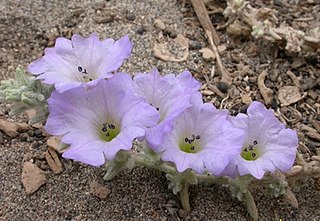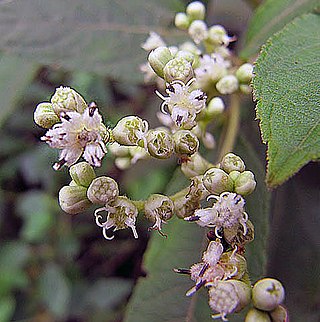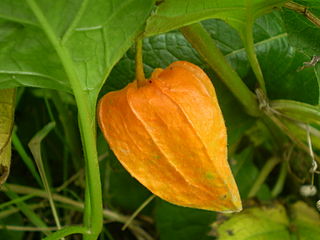
Iochroma is a genus of about 34 species of shrubs and small trees belonging to the nightshade family Solanaceae. Species are native from Mexico to south Brazil. They are found in the forests of Mexico and South America. Their hummingbird-pollinated flowers are tubular or trumpet-shaped, and may be blue, purple, red, yellow, or white, becoming pulpy berries. The cupular (cup-shaped) calyx is inflated in some species. The leaves are alternate, simple, and entire.

Lycium is a genus of flowering plants in the nightshade family, Solanaceae. The genus has a disjunct distribution around the globe, with species occurring on most continents in temperate and subtropical regions. South America has the most species, followed by North America and southern Africa. There are several scattered across Europe and Asia, and one is native to Australia. Common English names for plants of this genus include box-thorn, wolfberry, and desert-thorn. Plants of the World Online currently accepts 101 species. Other estimates are of 70 to 80 species.

Nolana is a genus of hard annual or perennial plants in the nightshade family. The genus is mostly native to Chile and Peru. Species in this genus, especially N. paradoxa, serve as a model system for studies on flower color.

Clibadium is a genus of flowering plants in the family Asteraceae.

Pseudogynoxys is a genus of flowering plant in the groundsel tribe within the sunflower family, native to North and South America.

Athenaea fasciculata is a species of flowering plant in the family Solanaceae. It is a shrub or tree which grows in the coastal Atlantic Forest of eastern Brazil, and ranges inland to northeastern Argentina, Paraguay, and Bolivia.

Brunellia is a genus of trees. They are distributed in the mountainous regions of southern Mexico, Central America, West Indies, and South America. Brunellia is the only genus in the family Brunelliaceae. As of 2001 there were about 54 species.
Solanum pseudoquina is a species of plant in the family Solanaceae. It is endemic to Brazil. A rare plant, it is dependent on conservation of its habitat to prevent it from becoming a threatened species.
Trianaea is a genus of the plant family Solanaceae. It occurs in Colombia, Ecuador and Peru. It is placed in the subfamily Solanoideae, tribe Juanulloeae.

Espeletia, commonly known as 'frailejones', is a genus of perennial subshrubs, in the family Asteraceae. The genus, which is native mainly to Colombia, Venezuela and Ecuador, was first formally described in 1808. The genus was named after the viceroy of New Granada, José Manuel de Ezpeleta.

Iochroma arborescens is a species of flowering plant in the genus Iochroma, belonging to the nightshade family Solanaceae. Formerly it was considered the single species in the monotypic genus Acnistus. Common names include gallinero, mata-gallina, fruta-de-sabiá, hollowheart, wild tobacco, siyou, bastard sirio, galán arbóreo, tabaco de monte, nigüito, marieneira, güitite, and tabak djab.
Westoniella is a genus of Costa Rican shrubs in the tribe Astereae within the family Asteraceae.

Physaleae is a tribe of flowering plants in the subfamily Solanoideae of the family Solanaceae.

Jaltomata is a genus of plants in the family Solanaceae. According to molecular phylogenies, Jaltomata is the sister genus to Solanum, which includes tomato, potato, and eggplant. Jaltomata has a neotropical distribution, in that species occur from the United States southwest through Latin America, and into the Andean region of South America. Species encompass a wide range of vegetative and reproductive trait variation, including growth habit, floral size, shape and color, as well as fruit size and color. The fruits of some of the species are eaten by humans in Latin and South America. Depending on the species, fruits may be red, green, orange, or dark purple.

The Solanaceae, or the nightshades, is a family of flowering plants that ranges from annual and perennial herbs to vines, lianas, epiphytes, shrubs, and trees, and includes a number of agricultural crops, medicinal plants, spices, weeds, and ornamentals. Many members of the family contain potent alkaloids, and some are highly toxic, but many—including tomatoes, potatoes, eggplant, bell, and chili peppers—are used as food. The family belongs to the order Solanales, in the asterid group and class Magnoliopsida (dicotyledons). The Solanaceae consists of about 98 genera and some 2,700 species, with a great diversity of habitats, morphology and ecology.
Schultesianthus is a genus of flowering plants belonging to the family Solanaceae.
Hawkesiophyton is a genus of flowering plants belonging to the family Solanaceae. It is also in Solanoideae subfamily, Tribe Solandreae Miers and also Subtribe Juanulloinae.
Merinthopodium is a genus of flowering plants belonging to the family Solanaceae.
Solanum cerasiferum is a species of plant in the nightshade family. It is native to tropical Africa.












